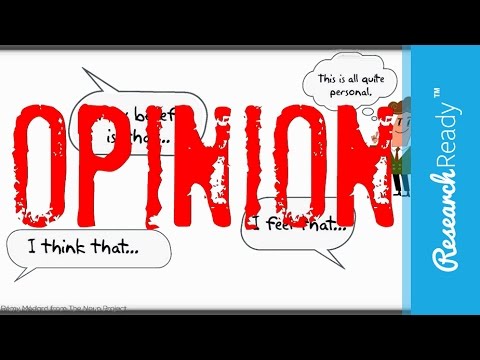36 Strategy: Fact versus opinion
Strategy: Fact versus opinion

The basics of fact versus opinion can be more complex than most realize. In addition, it is possible for facts to become opinions and vice versa.
Fact or Opinion
Thinking about the reason an author produced a source can be helpful to you because that reason was what dictated the kind of information he/she chose to include. Depending on that purpose, the author may have chosen to include factual, analytical, and objective information. Or, instead, it may have suited his/her purpose to include information that was subjective and therefore less factual and analytical. The author’s reason for producing the source also determined whether he or she included more than one perspective or just his/her own.An author’s purpose can influence the kind of information he or she chooses to include
Authors typically want to do at least one of the following:
- Inform and educate
- Persuade
- Sell services or products or
- Entertain
Combined Purposes
Sometimes authors have a combination of purposes, as when a marketer decides he can sell more smart phones with an informative sales video that also entertains us. The same is true when a singer writes and performs a song that entertains us but that she intends to make available for sale. Other examples of authors having multiple purposes occur in most scholarly writing.
In those cases, authors certainly want to inform and educate their audiences. But they also want to persuade their audiences that what they are reporting and/or postulating is a true description of a situation, event, or phenomenon or a valid argument that their audience must take a particular action. In this blend of scholarly author’s purposes, the intent to educate and inform is considered to trump the intent to persuade.
Why Intent Matters
Authors’ intent usually matters in how useful their information can be to your research project, depending on which information need you are trying to meet. For instance, when you’re looking for sources that will help you actually decide your answer to your research question or evidence for your answer that you will share with your audience, you will want the author’s main purpose to have been to inform or educate his/her audience. That’s because, with that intent, he/she is likely to have used:
- Facts where possible.
- Multiple perspectives instead of just his/her own.
- Little subjective information.
- Seemingly unbiased, objective language that cites where he/she got the information.
The reason you want that kind of resource when trying to answer your research question or explaining that answer is that all of those characteristics will lend credibility to the argument you are making with your project. Both you and your audience will simply find it easier to believe—will have more confidence in the argument being made—when you include those types of sources.
Sources whose authors intend only to persuade others won’t meet your information need for an answer to your research question or evidence with which to convince your audience. That’s because they don’t always confine themselves to facts. Instead, they tell us their opinions without backing them up with evidence. If you used those sources, your readers will notice and not believe your argument.
Fact vs. Opinion vs. Objective vs. Subjective
Need to brush up on the differences between fact, objective information, subjective information, and opinion?
Fact – Facts are useful to inform or make an argument.
Examples:
- The United States was established in 1776.
- The pH levels in acids are lower than pH levels in alkalines.
- Beethoven had a reputation as a virtuoso pianist.
Opinion – Opinions are useful to persuade, but careful readers and listeners will notice and demand evidence to back them up.
Examples:
- That was a good movie.
- Strawberries taste better blueberries.
- George Clooney is the sexiest actor alive.
- The death penalty is wrong.
- Beethoven’s reputation as a virtuoso pianist is overrated.
Objective – Objective information reflects a research finding or multiple perspectives that are not biased.
Examples:
- “Several studies show that an active lifestyle reduces the risk of heart disease and diabetes.”
- “Studies from the Brown University Medical School show that twenty-somethings eat 25 percent more fast-food meals at this age than they did as teenagers.”
Subjective – Subjective information presents one person or organization’s perspective or interpretation. Subjective information can be meant to distort, or it can reflect educated and informed thinking. All opinions are subjective, but some are backed up with facts more than others.
Examples:
- “The simple truth is this: As human beings, we were meant to move.”
- “In their thirties, women should stock up on calcium to ensure strong, dense bones and to ward off osteoporosis later in life.”*
*In this quote, it’s mostly the “should” that makes it subjective. The objective version of the last quote would read: “Studies have shown that women who begin taking calcium in their 30s show stronger bone density and fewer repercussions of osteoporosis than women who did not take calcium at all.” But perhaps there are other data showing complications from taking calcium. That’s why drawing the conclusion that requires a “should” makes the statement subjective.
Built In Practice: Face versus Opinion
Try this quiz!
Built-In Practice: Fact versus Opinion
In small groups discuss and create a list of at least 5-10 facts and opinions. Once the lists are completed, research to determine if they are a fact or opinion. Discuss the results with the class and instructor.
|
Facts |
Opinions |
|
|
|
|
|
|
|
|
|
|
|
|
|
|
|
|
|
|
|
|
|
Find three examples of what was once considered opinion and is now fact and vice versa.
|
WAS Opinion |
NOW Fact |
|
|
|
|
|
|
|
|
|
Make a chart consisting of three columns. Label the columns as Fact, Opinion, Fiction.
|
Facts |
Opinions |
Fiction |
|
|
|
|
|
|
|
|
|
|
|
|
|
|
|
|
Next, visit this image of a baseball field.
https://en.wikipedia.org/wiki/Baseball#/media/File:Angels_Stadium.JPG
Observe it carefully. Then generate a list of facts and opinions about the image (or about baseball in general). For the fun of it, create a few “fictions” to complete the chart.
|
Facts |
Opinions |
|
|
|
|
|
|
|
|
|
|
|
|
|
|
|
On the back of your chart, write your own definitions of fact, opinion, and fiction (based on prior knowledge). In other words, resist the urge to look them up. Later, you can come back to your chart and definitions to see if you were accurate.
You might like this little Quizlet to check your understanding of Facts versus Opinions.
Watch What Is A Fact? on BrainCraft about the science behind what makes a fact a fact.
When finished, list three facts and three opinions you have about the video, along with any questions you have.
|
Facts |
Opinions |
|
|
|
|
|
|
|
|
|
|
|
|
|
|
|
Watch this video on facts vs. opinions in research writing (great resource for constructing arguments).
Click here to take the quiz online. https://www.goconqr.com/en-US/p/9729683-Fact–Opinion-or-Just-Fiction–quizzes You do not have to log into the quiz site in order to take this quiz. If a window pops up asking you to sign up for the quiz site, just close the sign-up window and start your quiz.
© 2007 – 2020, OER Commons A project created by ISKME. Except where otherwise noted, content on this site is licensed under a Creative Commons Attribution-NonCommercial-ShareAlike 4.0 License.

